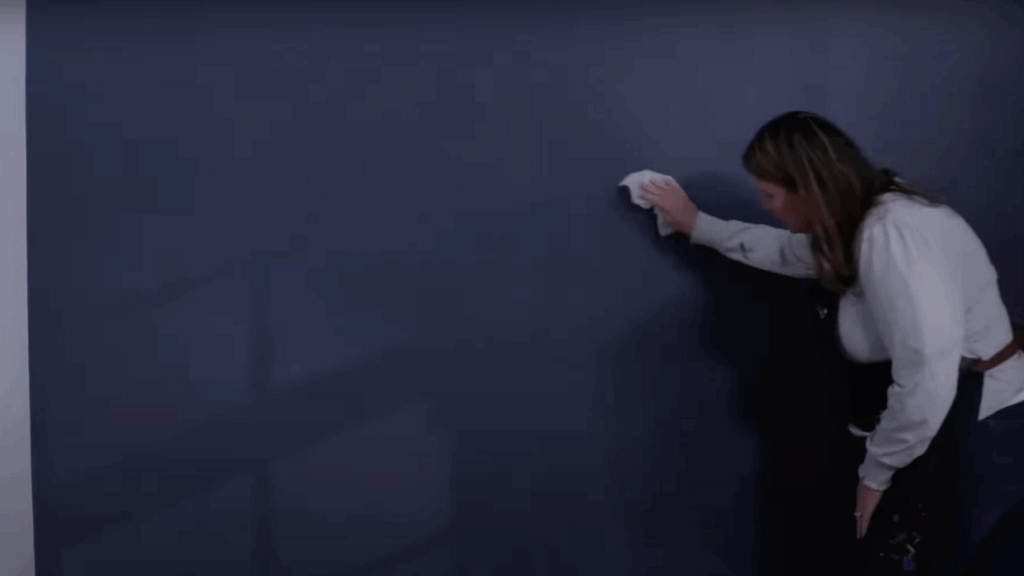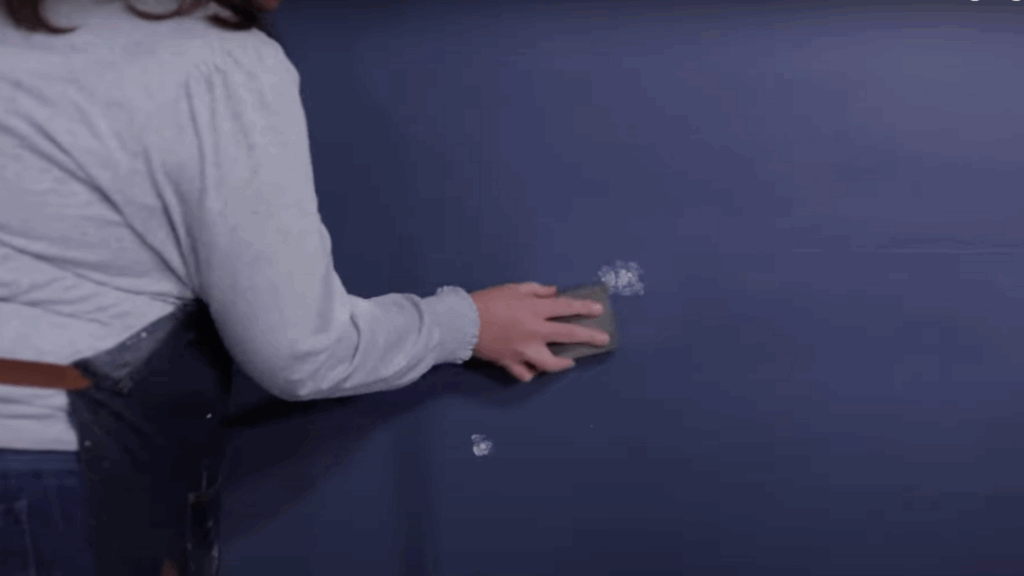Are you tired of looking at dark walls that make your space feel smaller or gloomy?
If you’re thinking about giving your room a fresh look, painting over dark walls can be a bit tricky. But don’t worry, I’ve got you covered.
I’ll share simple steps to successfully paint over dark walls without the hassle. In this article, I’ll cover:
- What you need to prepare before you start painting
- Tips on choosing the right primer
- Step-by-step instructions to get the job done easily
By the end of this, you’ll feel confident about changing your space, even if those dark colors have been there for years. Let’s get started!
Why Is Painting Over Dark Walls Challenging?
Painting over dark walls can be challenging for several reasons. Dark colors, particularly deep tones like navy, burgundy, or charcoal, tend to absorb more light, making it harder for lighter colors to fully cover them.
When applying a lighter paint over dark walls, the underlying dark color can “bleed through,” causing uneven or streaky patches.
This often results in the need for multiple coats of paint to achieve the desired finish.
Additionally, dark paints typically have a richer, more saturated base that can create patchy results if not properly covered.
To prevent this, a good primer is essential to block out the dark hue and provide a smooth surface. This process requires extra time and patience, but with the right techniques, you can achieve a clean, even look.
Steps for Painting Over Dark Walls
Follow these steps to ensure a smooth, even application when painting over dark walls, from cleaning and prepping the surface to applying primer and paint for a flawless finish.
Materials Needed
To make the process of painting over dark walls easier, you’ll need the right tools and materials. This is a list of what you’ll need to get started:
- Paint: Choose the color you want. Ensure it’s of high quality and suitable for the surface you’re painting
- Primer: A good quality primer helps block out dark colors and ensures a smooth finish.
- Painter’s Tape: Used for masking off trim, windows, and moldings to protect them from paint.
- Spackle: For filling in holes, cracks, and other imperfections on the wall.
- Sanding Sponge: To smooth surfaces, especially if you have a high-gloss finish on the wall.
- Paintbrush: Used for cutting in around edges and corners.
- Paint Roller: For painting large areas of the wall evenly.
- Drop Cloths: To protect your furniture and flooring from paint splatters.
- Clean Cloth: For wiping down surfaces and cleaning up dust after sanding.
Step 1: Clean the Walls

Before you start painting, make sure the walls are clean and free from dirt, dust, and any debris. Use a mild soap and water solution or a gentle cleaner to wipe down the surface.
If there are areas where paint is peeling or uneven, scrape them off to ensure a smooth base for painting. A clean, smooth surface is crucial for the best results.
Step 2: Patch Holes and Divots

Fill any nail holes, divots, or imperfections in the wall with spackle. Once the spackle dries, sand it smooth with a fine-grit sanding sponge.
If the walls have any large cracks or dents, take the time to fix them before proceeding. This will help create a flawless surface and prevent imperfections from showing through your new paint.
Step 3: Sand High-Gloss Finishes

If the wall is painted with a gloss or high-gloss finish, it’s important to smooth it before applying new paint. Use a light-grit sanding sponge to roughen the surface slightly.
This will ensure that the new paint adheres well and prevents streaking or peeling later on. Be sure to wipe away any dust after sanding to keep the surface clean.
Step 4: Tape the Edges

Use painter’s tape to mask off areas like moldings, windows, doors, and trim. Press the tape down evenly to prevent bleed-through.
After applying the tape, run a damp cloth along the edges to ensure the tape sticks securely to the wall. This helps to prevent any paint from bleeding into the areas you want to keep clean.
Step 5: Apply Primer

A good primer is essential when painting over dark walls. It will help disguise the old color, create a smooth surface, and ensure the new paint covers evenly.
For dark colors, a primer like Zinsser Bullseye 123 is a great choice, as it blocks out dark hues and provides a solid base. Apply a thin, even coat and allow it to dry completely before moving on to the next step.
Step 6: Cut in the Edges

Once your primer has dried, use a paintbrush to cut in around the edges of the room. Paint a few inches along the edges of the wall, including the corners, trim, and ceiling.
Take your time to ensure clean, straight lines. It’s best to do one wall at a time to ensure that the paint remains workable and doesn’t dry out.
Step 7: Start Rolling

After cutting in the edges, use a roller to paint the larger areas of the wall. Work in a “W” or “V” shape to ensure even coverage. Apply paint from top to bottom and continue working in sections.
This technique, called “working to a wet edge,” ensures that the paint blends seamlessly without streaks. Keep your roller fully loaded with paint to avoid uneven coverage.
For a visual guide, refer to this video by @Ace Hardwareon YouTube.
Why Choose Paint Over Other Methods?
Painting over dark walls offers several advantages that make it an appealing option.
It’s an affordable and efficient way to change a room, especially when compared to more complex methods like wallpapering or retexturing.
Unlike other finishes, paint is quick to apply and doesn’t require extensive preparation or clean-up. DIY enthusiasts appreciate the range of color options available, allowing for full customization to suit any visuals.
Additionally, paint allows for easy touch-ups and provides a smooth, durable finish that doesn’t peel or fade over time, unlike wallpaper.
It also offers great flexibility in achieving various effects, from glossy to matte, giving the room the desired visual look.
Overall, painting is a practical, budget-friendly solution for those looking to refresh their space without the hassle and expense of other renovation methods.
The Cost of Painting Over Dark Walls
The cost of painting over dark walls can vary depending on several factors, such as the size of the room, the type of paint, and the preparation required.
In most cases, you will need a high-quality primer to block the dark color from bleeding through, and a durable paint that works well over dark shades.
On average, primer costs around $15–$30 per gallon, and quality paint can range from $30 to $60 per gallon. For a standard 10×12 room, you might need 1-2 gallons of primer and 2-3 gallons of paint.
Additionally, investing in tools such as brushes, rollers, painter’s tape, and drop cloths will add to the cost. DIYers often recommend buying extra paint to account for multiple coats and touch-ups.
All in all, expect to spend anywhere from $100 to $300, depending on the scope of the project.
Community Advice on How to Paint Over Dark Walls
DIY forums and online communities are full of tips and advice from homeowners who have faced the challenge of painting over dark walls.
- Use a High-Quality Primer: A stain-blocking primer like Zinsser Bulls Eye 1-2-3 or Kilz Original creates a smooth base for lighter paint and prevents dark colors from showing through.
- Don’t Skip the Sanding: Sand the walls lightly to smooth imperfections and improve paint adhesion, then clean the walls to remove dust.
- Choose the Right Paint Color: Choose lighter colors designed to cover dark hues effectively, like Benjamin Moore’s Aura or Sherwin-Williams’ Cashmere. Pick a color that complements your room’s style and provides the desired effect.
- Let Each Coat Dry Thoroughly: Allow each coat of paint to dry completely before applying the next. It’s typically recommended to wait at least 4 hours between coats to prevent smudging and ensure proper adhesion.
- Number of Coats of Paint: Expect to apply two to three coats when painting over dark walls. A fourth coat may be needed for vibrant or bold dark colors to achieve full coverage.
- Use a Quality Paintbrush and Roller: Invest in high-quality tools, such as a microfiber roller for large areas and an angled brush for edges, to achieve a smooth, streak-free finish and precise application.
- Test Paint Before Committing: Test the new paint color on a small section of the wall to see how it works with the dark base and determine how many coats are necessary before committing to the entire room.
Tips for the Best Finish Over the Dark Walls
Use these tips to achieve the best results and a smooth, even finish when painting over dark walls, ensuring long-lasting coverage.
- Cutting In: Apply painter’s tape to safeguard trim, baseboards, and ceilings. This helps create clean lines and a polished finish.
- Avoid Overworking the Paint: Once the paint is on the wall, don’t keep going over it with the roller or brush, as this can create uneven areas.
- Use Light Reflecting Colors: Light, soft tones help the room appear larger and brighter. Consider whites, light grays, or pastel shades to make the space feel more open.
- Blend in the Corners: Be sure to blend the paint in the corners and edges of the wall to avoid visible lines or inconsistencies.
Conclusion
Painting over dark walls is a simple and cost-effective way to transform your space, as long as you follow the proper steps.
With the proper prep work, quality primer, and multiple coats of paint, you can successfully cover dark colors and achieve a fresh, bright room.
With the right tools and some effort, you can achieve a smooth, professional finish.
The extra care you put in will make a big difference in the final result. If you’re ready to take on the task, I encourage you to give these tips a try.
Feel free to reach out if you need personalized advice or want to make sure you’re using the best products for the task. By taking the right approach, you’ll create a refreshed space that feels brighter and more welcoming.

